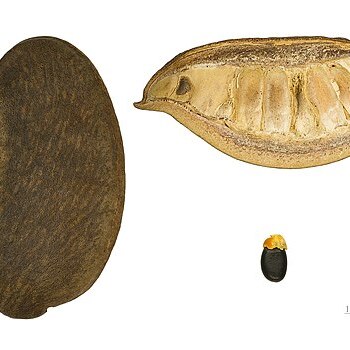Tree 6–30 m. high, with flat or rounded spreading crown; bark grey to dark brown, scaly; branchlets glabrous.. Leaves: rhachis with petiole 4–32 cm. long or more; leaflets (mature) 2–5(–6) pairs, petiolulate, elliptic to ovate-elliptic, mostly 5–15 cm. long, 2.8–6.9(–8.5) cm. wide, obtusely pointed to ± acuminate at apex.. Inflorescences paniculate, with racemose branches 3–13 cm. long, rarely (? casually and by reduction) inflorescence simply racemose.. Flowers sweetly scented, with hypanthium 0.3–0.6 cm. long.. Sepals shortly and densely velvety-pubescent or-puberulous outside, broadly obovate-elliptic to rotund, 2 outer 6–9 mm. long, 5–7 mm. wide, 2 inner 7–11 mm. long, 6–10 mm. wide.. Large petal 1.1–2 cm. long, white or greenish-white, with pinkish-crimson streak down centre, with a rather long claw suddenly widened into a bilobed lamina 0.7–1.1 cm. wide.. Stamens 7 fertile, with ± pubescent filaments.. Style ± pubescent below.. Pods straight, 10.5–20.5 cm. long, 5.5–8.5 cm. wide.. Seeds black, ellipsoid or oblong-ellipsoid, 1.6–3 cm. long, 1.1–2.1 cm. wide, with an orange cup-shaped basal aril.
More
A large tree. It grows 6-30 m tall. Often is loses its leaves during part of the year. It has thick branches. It has short thick buttresses near the base. The bark is dark brown. Large pieces of bark flake off. The leaves are compound. The leaf stalks are 32 cm long. There are 2-5 pairs of leaflets. They are oval and 5-15 cm long. The tip is pointed. The flowers occur in heads about 10 cm long. Each flower is 1-2 cm long and has only one petal. The flower is green-white with pink lines. The fruit is a large woody straight pod. It can be 10-20 cm long and 5-8 cm wide. The seeds are black and 3 cm long. They are half covered with a soft bright orange aril. They lie in white pith.
Humid and dry forests, tree savannahs, forest galleries. Semi-deciduous forest and savannahs to the southern border of the Sahel. Found in the drier parts of the tropical forests region in valleys, on the savannah and in areas fringing forests.
More
It grows in the tropics. It grows in wooded grassland and better rainfall areas. It can grow in dry stony soils. It grows between 1,220-1,370 m above sea level. It can grow in arid places.
Plants are grown from seed. Seed can be self sown, sown where they are to grow or can be put in a nursery. The orange aril should be removed from the seed and cutting the seed coat slightly may help seed germinate. Seed can be stored for a long time in an airtight container. Plants can be budded.


